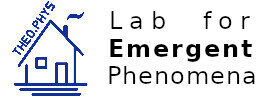PhD thesis – Sebastian Kapfer
Sebastian Kapfer
Morphometry and Physics of Particulate and Porous Media
finished 2011-12
supervised by Klaus Mecke and Gerd Schröder-Turk
Robust and quantitative characterization of the morphology is a prerequisite for insight into the link between spatial structure and the physical properties of complex materials. Procedures for the application of a recent class of morphometric quantities, termed Minkowski tensors, to experimental and simulated physical systems, and the results from this analysis are presented. Furthermore, the mechanical properties of minimal surface scaffolds and their dependence on the morphology is studied, and a new type of scaffold design for tissue engineering is proposed. — Minkowski tensors are tensor-valued metrics that generalize Minkowski functionals, existing scalar metrics based on integral and convex geometry, towards anisotropic structures. In this work, methods and algorithms are developed to analyze cellular structures, percolating and polycontinuous geometries and particle ensembles. Applications to micrographs of ice grains from Antarctic cores, and to stationary states of Turing patterns are presented in the planar case. Both in two and three dimensions, the free volume available to individual particles have previously been studied for simple and complex fluids; using Minkowski tensors, the shape of free volume (Voronoi) cells is analyzed, yielding structural information beyond the two-point correlation function. For the hard disk, hard sphere and Lennard-Jones ensembles, it is found that anisotropy indices based on Minkowski tensors are robust metrics sensitive to structural transitions and that local anisotropy increases monotonously with increasing free volume and disorder. In jammed bead packings, rank-four Minkowski tensors are used to detect and classify crystallinity. A discontinuous transition in amorphous packings, signalling the onset of crystallization, is observed at a limiting packing fraction higher than the consensus for the random close packing. The Minkowski tensor method is contrasted with existing metrics of structure in particulate matter, especially bond orientation analysis; the Minkowski method is found to be related but more robust due to its independence of the problematic particle neighbourhood concept. — The mechanical properties of porous solids based on the labyrinth domains of triply-periodic minimal surfaces (TPMS) are studied using finite-element modelling, and variations of channel diameter are found dominate the mechanical stiffness. A new type of scaffold architecture is proposed, which results from inflation of TPMS to a finite-thickness sheet solid. Sheet solids are found to be stiffer than conventional scaffolds, and provide a higher specific surface area; they are thus promising candidates as a scaffold architecture for tissue engineering.
